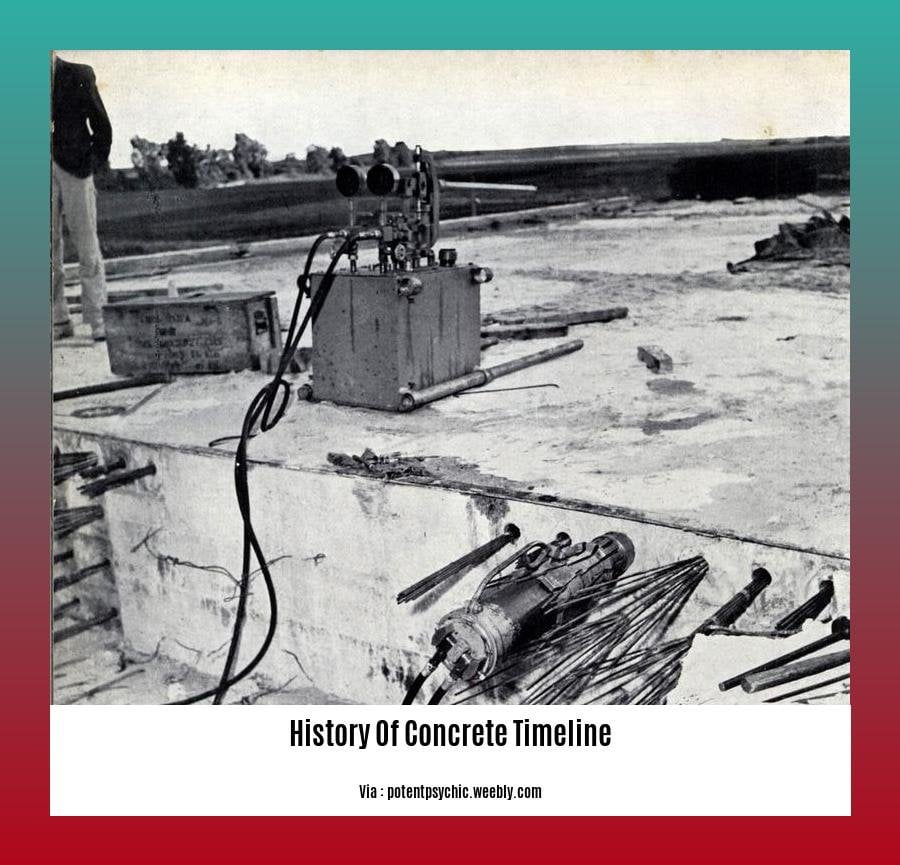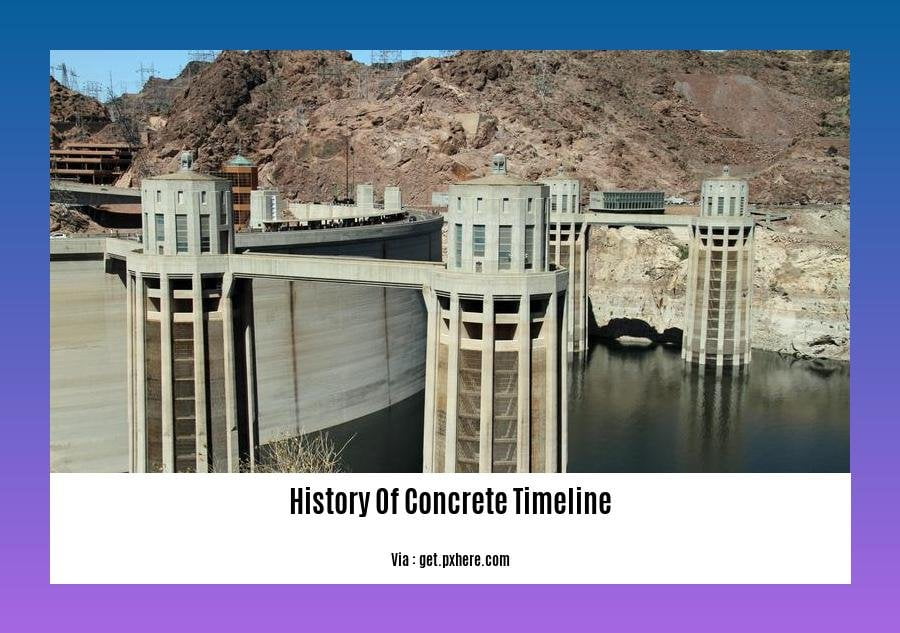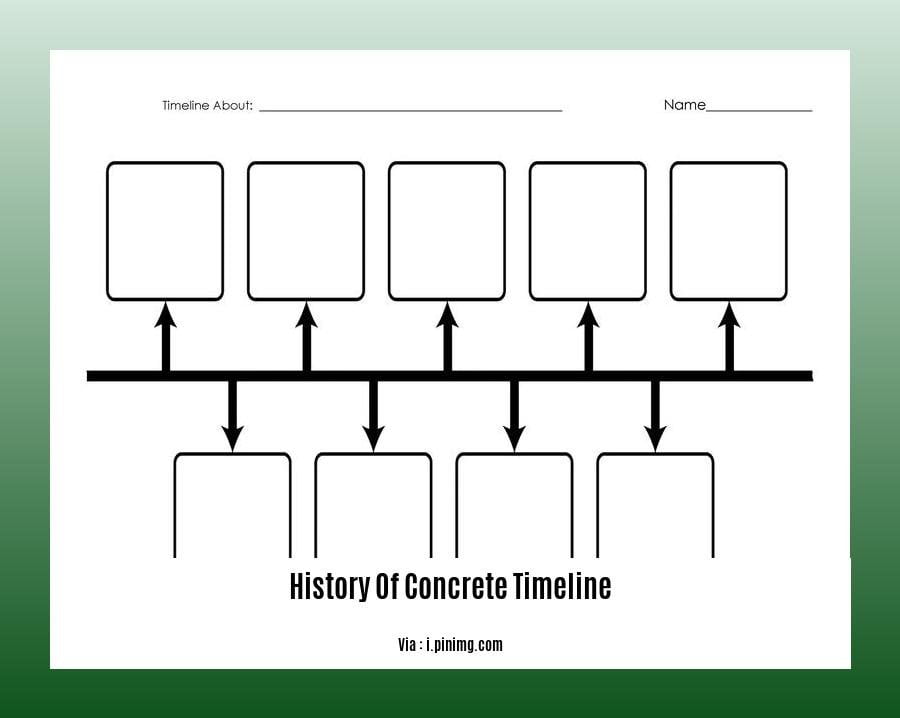From ancient Roman structures that still stand tall to the towering skylines of modern cities, concrete has played a pivotal role in shaping the built environment throughout history. In this article, titled “A Concrete Timeline: Tracing the Evolution of a Construction Powerhouse,” we embark on a journey to explore the remarkable story of concrete, from its humble beginnings to its transformation into a cornerstone of modern construction practices.
Key Takeaways: Tracing the Evolution of a Construction Powerhouse
- Concrete’s presence dates back over 7,000 years.
- From primitive mixtures in the Stone Age to contemporary skyscrapers, concrete’s versatility is remarkable.
- The Middle East’s early use of lime and water was further refined by the Ancient Egyptians with mud bricks and lime for their pyramids.
- The Romans developed opus caementicium, a durable mix of volcanic ash, lime, and aggregate, seen in structures like the Pantheon.
- Concrete’s prominence waned in medieval Europe but thrived in the Middle East and Asia.
- Joseph Aspdin’s invention of Portland cement in the 18th century revolutionized concrete technology.
- Iconic structures like the Eiffel Tower and Brooklyn Bridge emerged in the 19th century, showcasing concrete’s potential.
- In the 20th century, concrete became ubiquitous in roads, bridges, and infrastructure projects.
- Today, concrete reigns as the most widely used man-made material, spanning buildings, roads, bridges, and dams, due to its strength, durability, and cost-effectiveness.
History of Concrete Timeline

Concrete’s legacy is a testament to human ingenuity and its quest to create durable structures. Join us as we trace the remarkable journey of concrete through the ages, from its humble beginnings to its status as a construction powerhouse.
Ancient Foundations: The Genesis of Concrete
The origins of concrete can be traced back to the 7th millennium BCE when people in the Middle East used a mixture of lime and water to create a primitive form of concrete. This rudimentary concrete was used to construct dwellings and other structures.
Egyptian Advancements: Constructing the Pyramids
In the 3rd millennium BCE, the Ancient Egyptians further refined concrete technology. They employed a mix of mud bricks, lime, and sand to build the awe-inspiring pyramids of Giza. These structures showcase the Egyptians’ mastery of construction techniques and their innovative use of concrete.
Roman Ingenuity: Opus Caementicium
The Romans took concrete technology to new heights with their invention of opus caementicium, a concrete composed of volcanic ash, lime, and aggregate. This durable and versatile material enabled the Romans to construct iconic structures like the Pantheon and the Colosseum, which have stood the test of time.
Medieval Stagnation and Eastern Innovations
During the Middle Ages, concrete fell out of favor in Europe due to the decline of Roman civilization. However, in the Middle East and Asia, concrete continued to be used. The Chinese, in particular, developed rammed earth, a type of concrete made from compacted earth, which is still used today.
The Renaissance of Concrete: Portland Cement
The 18th century marked a turning point in the history of concrete with the invention of Portland cement by Joseph Aspdin. This hydraulic cement, which hardens when mixed with water, revolutionized concrete construction and laid the foundation for modern concrete technology.
19th Century Achievements: Engineering Marvels
The 19th century witnessed the rise of concrete as a preferred material for constructing some of the world’s most iconic structures. The Eiffel Tower, Brooklyn Bridge, and many other architectural landmarks stand as testaments to the strength and versatility of concrete.
20th Century: Concrete’s Dominance
In the 20th century, concrete became the go-to material for infrastructure projects, from roads and bridges to dams and buildings. Its widespread use was driven by its strength, durability, and cost-effectiveness.
Modern Applications: A Ubiquitous Material
Today, concrete is the most widely used man-made material globally. It is used in a vast array of applications, including buildings, roads, bridges, dams, and more. Concrete’s versatility and durability have made it an indispensable component of modern construction.
The history of concrete timeline is a chronicle of innovation, experimentation, and engineering prowess. From its ancient origins to its modern applications, concrete has played a crucial role in shaping our built environment and continues to be a cornerstone of construction practices worldwide.
- There is a very fascinating and engaging story about the evolution and development of contemporary dance. history of contemporary dance
- There’s a uniquely American tale about how the photocopier evolved from novelty to necessity. history of copiers
- There’s a transformative account about the development of the copy machine from its early inception to its modern-day ubiquity. history of copy machines
The History of Concrete Timeline

Concrete has been an integral part of construction for millennia. Discover the captivating journey of this construction powerhouse, from its humble origins to its modern-day prevalence.
Key Takeaways:
The earliest concrete dates back over 12,000 years, utilized by ancient civilizations for basic structures.
The Ancient Egyptians were among the first to use concrete, employing a mixture of mud bricks, lime, and sand to build monumental structures like the pyramids.
The Romans took concrete to new heights, developing a durable blend of lime, pozzolana, and aggregate that enabled the construction of iconic structures like the Pantheon and Colosseum.
Concrete’s usage declined during the Middle Ages in Europe but flourished in the Middle East and Asia.
The invention of Portland cement in the 18th century revolutionized concrete technology, leading to its widespread use in modern construction.
The Eiffel Tower, Brooklyn Bridge, and Hoover Dam stand as testaments to concrete’s versatility and strength in the 19th and 20th centuries.
Concrete’s durability and affordability have solidified its position as the world’s most widely-used man-made material.
Concrete’s evolution continues today, with innovations like self-healing concrete and green concrete paving the way for a sustainable future.
Concrete’s impact on the construction industry cannot be overstated. Its durability, strength, and versatility have transformed skylines worldwide, from towering skyscrapers to sprawling infrastructure projects. As we delve deeper into concrete’s history, we appreciate the ingenuity and innovation that have shaped our built environment.
Sources:
– The Invention of Concrete: A Complete History
- Timeline of Concrete & Cement History
History of Concrete Timeline Essay
In the world of construction, concrete stands as a cornerstone material, shaping the foundations of our built environment. Throughout history, its journey from humble beginnings to a global construction powerhouse is a testament to human ingenuity and the relentless pursuit of innovation. Embark on a chronological journey through the History Of Concrete Timeline Essay to uncover the remarkable story of this versatile material.
Key Takeaways:
Concrete’s origins can be traced back to ancient civilizations, where it was used in a rudimentary form for basic structures.
The Egyptians played a pivotal role in the evolution of concrete, employing a mixture of mud bricks, lime, and sand to construct iconic structures like the pyramids.
The Romans refined concrete technology, developing a durable blend that enabled the construction of renowned structures like the Pantheon and Colosseum.
During the Middle Ages, concrete’s usage declined in Europe but continued to flourish in the Middle East and Asia.
The invention of Portland cement in the 18th century revolutionized concrete technology, leading to its widespread use in modern construction.
The 19th and 20th centuries witnessed the rise of concrete as a construction material of choice, with iconic structures like the Eiffel Tower and Brooklyn Bridge showcasing its versatility and strength.
Today, concrete remains the world’s most widely-used man-made material, with innovations like self-healing and green concrete paving the way for a sustainable future.
From Ancient Origins to Global Powerhouse
- Ancient Foundations:
Concrete’s earliest roots can be traced back to ancient civilizations like the Babylonians and Assyrians, who used a mixture of mud, clay, and bitumen to construct basic structures.
Egyptian Ingenuity:
The Egyptians made significant strides in concrete technology by developing a mixture of mud bricks, lime, and sand. This durable material formed the foundation of iconic structures like the pyramids, showcasing the Egyptians’ mastery of construction techniques.
Roman Innovations:
The Romans further refined concrete technology, creating a durable blend known as opus caementicium. Composed of volcanic ash, lime, and aggregate, this concrete enabled the construction of magnificent structures like the Pantheon and Colosseum, which continue to stand as testaments to Roman engineering prowess.
Medieval Decline and Eastern Flourishing:
- With the fall of the Roman Empire, the use of concrete declined in Europe during the Middle Ages. However, in the Middle East and Asia, it continued to flourish. The Chinese, in particular, developed rammed earth, a type of concrete still used today to build homes and other structures.
Modern Advancements and Global Dominance
- Portland Cement Revolution:
The invention of Portland cement in the 19th century marked a turning point in concrete technology. This hydraulic cement, developed by Joseph Aspdin, revolutionized construction by hardening when mixed with water.
Concrete’s Rise to Prominence:
The 19th and 20th centuries witnessed the rise of concrete as a construction material of choice. Its strength, durability, and versatility made it ideal for building roads, bridges, and other infrastructure projects.
Contemporary Innovations:
- In recent years, concrete technology has continued to evolve, with innovations like self-healing concrete and green concrete paving the way for a sustainable future. These advancements aim to reduce concrete’s environmental impact while enhancing its performance and durability.
Concrete’s journey through history is a testament to its enduring strength, versatility, and adaptability. From ancient origins to modern-day applications, concrete has played a pivotal role in shaping our built environment. As we continue to push the boundaries of concrete technology, the future holds endless possibilities for this remarkable material.
References
History of Concrete: Timeline of Concrete
FAQ
Q1: What are the key developments in the history of concrete?
A1: Throughout history, concrete has undergone various advancements, from the early use of lime-based mixtures in the Middle East to the invention of Portland cement in the 18th century. The Romans significantly contributed with their opus caementicium, while the Chinese developed rammed earth.
Q2: Why did concrete fall out of use in Europe during the Middle Ages?
A2: During the Middle Ages, concrete’s usage declined in Europe due to the scarcity of volcanic ash, a crucial component in Roman concrete. Additionally, the fall of the Roman Empire and the subsequent political and economic instability contributed to this decline.
Q3: How did the invention of Portland cement impact the construction industry?
A3: The invention of Portland cement by Joseph Aspdin in the 18th century revolutionized the construction industry. Portland cement’s hydraulic properties allowed concrete to harden underwater, making it suitable for a broader range of applications, leading to its widespread adoption in modern construction practices.
Q4: What are some iconic structures built using concrete in the 19th century?
A4: The 19th century witnessed the construction of several iconic structures using concrete, including the Eiffel Tower in Paris, France, and the Brooklyn Bridge in New York City, USA. These landmarks showcased the potential and versatility of concrete as a building material.
Q5: What are the advantages of concrete that make it a popular choice in modern construction?
A5: Concrete’s popularity in modern construction stems from its numerous advantages. It is strong, durable, and relatively inexpensive, making it suitable for a wide range of applications. Additionally, concrete can be molded into various shapes and reinforced with steel for increased strength, making it a versatile material for complex structures.
- Unlock Elemental 2 Secrets: Actionable Insights Now - April 2, 2025
- Lot’s Wife’s Name: Unveiling the Mystery of Sodom’s Fall - April 2, 2025
- Photocell Sensors: A Complete Guide for Selection and Implementation - April 2, 2025
















